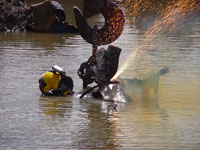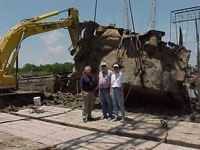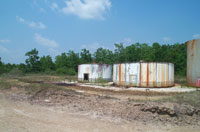| |
 Programs & Services
Programs & Services
 Download Adobe Reader Download Adobe Reader |
|
Some documents on this page are in PDF format. Click here to download the free Adobe Reader.

|
|
Prevention |
|
|
 Louisiana’s natural resources are susceptible to oil spill injuries from a variety
of sources. Among them are shipping, land-based
oil fields, oil platforms in state waters, oil
storage facilities, oil terminals/ports, crude
or refined oil pipelines, oil refineries, abandoned
vessels, pits, reservoirs, and other industries
using oil in their operations. The primary objective
of the Louisiana Oil Spill Coordinator’s
Office (LOSCO) Prevention Program is to prevent
the occurrence of unauthorized discharges of oil
that impact Louisiana’s resources. Louisiana’s natural resources are susceptible to oil spill injuries from a variety
of sources. Among them are shipping, land-based
oil fields, oil platforms in state waters, oil
storage facilities, oil terminals/ports, crude
or refined oil pipelines, oil refineries, abandoned
vessels, pits, reservoirs, and other industries
using oil in their operations. The primary objective
of the Louisiana Oil Spill Coordinator’s
Office (LOSCO) Prevention Program is to prevent
the occurrence of unauthorized discharges of oil
that impact Louisiana’s resources.
 While planning, training, participation
in drills, and public awareness all serve to prevent
oil spills from happening, LOSCO recognized early
on that the widespread, aging oil and gas infrastructure
in Louisiana creates a potential major source for
oil spills. With 100 years of oil and gas development
in Louisiana and limited long-term records, a critical
need of the Prevention Program has been obtaining
a true picture of the scope of the problem. In the
past several years, a large component of LOSCO’s
Prevention Program has focused on locating potential
oil spill locations and assessing the risks associated
with these sites. To directly enhance prevention
and eliminate the threat of unauthorized discharges,
LOSCO initiated the Abandoned Barge and Abandoned
Facilities Programs. While planning, training, participation
in drills, and public awareness all serve to prevent
oil spills from happening, LOSCO recognized early
on that the widespread, aging oil and gas infrastructure
in Louisiana creates a potential major source for
oil spills. With 100 years of oil and gas development
in Louisiana and limited long-term records, a critical
need of the Prevention Program has been obtaining
a true picture of the scope of the problem. In the
past several years, a large component of LOSCO’s
Prevention Program has focused on locating potential
oil spill locations and assessing the risks associated
with these sites. To directly enhance prevention
and eliminate the threat of unauthorized discharges,
LOSCO initiated the Abandoned Barge and Abandoned
Facilities Programs.
|
|
|
Abandoned Barge
Program |
|
|
| |
|
The Abandoned
Barge Program began in 1993 and is aimed at minimizing
the threat of
an
oil spill by locating and removing abandoned barges
or vessels that pose a high risk for unauthorized
discharge of oil. The first phase of this program
consisted of conducting an inventory of the abandoned
vessels/barges in the state’s coastal waters
and developing a priority ranking for removal.
The inventory was finalized in 1996 and identified
approximately
800 abandoned vessels/barges of which roughly 200
were characterized as posing a potential pollution
problem.
The second phase of the Abandoned
Barge Program focuses on the systematic removal
of
the abandoned
vessels/barges. The
Louisiana Oil Spill Prevention and Response Act
of 1991 (OSPRA), La. Rev. Stat.
30:2451 et seq., authorizes
up to one million dollars per year for the removal
of abandoned
or derelict vessels/barges in Louisiana’s
coastal waters. To maximize its resources, LOSCO
established
a partnership with the U.S. Coast Guard (USCG)
and U.S. Environmental Protection Agency (USEPA)
to remove
the abandoned oil-bearing vessels/barges and
eliminate the threat of a potential discharge.
Removal of
the oil-bearing vessels/barges is being done
through a cooperative effort known as the Joint
Operating
Procedures (JOP) Program. The procedure calls
for a determination of potential owners/operators
and,
if the owner/operator cannot be identified, the
cleanup
of the vessels/barges by the federal agencies.
Subsequent removal of the cleaned vessels/barges
is done by
either the state or federal agencies depending
on the potential for midnight dumping. Where
the threat
of midnight dumping can be confirmed or is significant,
vessels/barges removal is the responsibility
of the federal partners in the JOP; in the absence
of such
a threat removal of vessels/barges becomes the
responsibility of the state. While several barges
have been removed
through the JOP, the program has prompted many
owners to remove vessels on a voluntary basis. |
 |
|
|
Abandoned Facilities
Program |
|
 In 1992, LOSCO initiated the Abandoned Facilities Program to locate and
remove structures, pits, and wells that pose a high risk for unauthorized discharge
of oil. A total of approximately 25,000 facilities,
pits, sumps, or reservoirs in the Louisiana coastal
area have been inventoried and evaluated to determine
the sites that pose the highest risk to human health
and safety, environment, and wildlife habitat through
actual or potential discharge of oil. The majority
of the abandoned sites consisted of wells (60%),
facilities (15%), and tank batteries (8%). The remaining
sites were classified as manifold headers, metering
stations, docks, rigs, and pits. In 1992, LOSCO initiated the Abandoned Facilities Program to locate and
remove structures, pits, and wells that pose a high risk for unauthorized discharge
of oil. A total of approximately 25,000 facilities,
pits, sumps, or reservoirs in the Louisiana coastal
area have been inventoried and evaluated to determine
the sites that pose the highest risk to human health
and safety, environment, and wildlife habitat through
actual or potential discharge of oil. The majority
of the abandoned sites consisted of wells (60%),
facilities (15%), and tank batteries (8%). The remaining
sites were classified as manifold headers, metering
stations, docks, rigs, and pits.
|
The Louisiana Oil
Spill Prevention and Response Act of 1991 (OSPRA),
La. Rev. Stat.
30:2451 et seq. authorizes up to two million dollars
per year for the abatement of unauthorized discharges
of oil from abandoned facilities or structures
in Louisiana. LOSCO established a partnership with
the Louisiana Department of Natural Resources/Office
of Conservation (LDNR/OC)
to plug abandoned wells that pose a high risk for
unauthorized discharge of oil and eliminate the
threat of a potential discharge from these sites.
This joint venture has resulted in the plugging
and abandonment of many wells. In addition, LOSCO
recently expanded the abandoned barges/vessels
JOP to incorporate abandoned facilities as well.
Our allies in this ongoing program include the
LDNR/OC, the USEPA, the USCG, the U.S. Bureau of
Reclamation (USBR), and the U.S. Army Corps of
Engineers (USACE).
|
| |
|
|
|
 |
| |
|
|
|